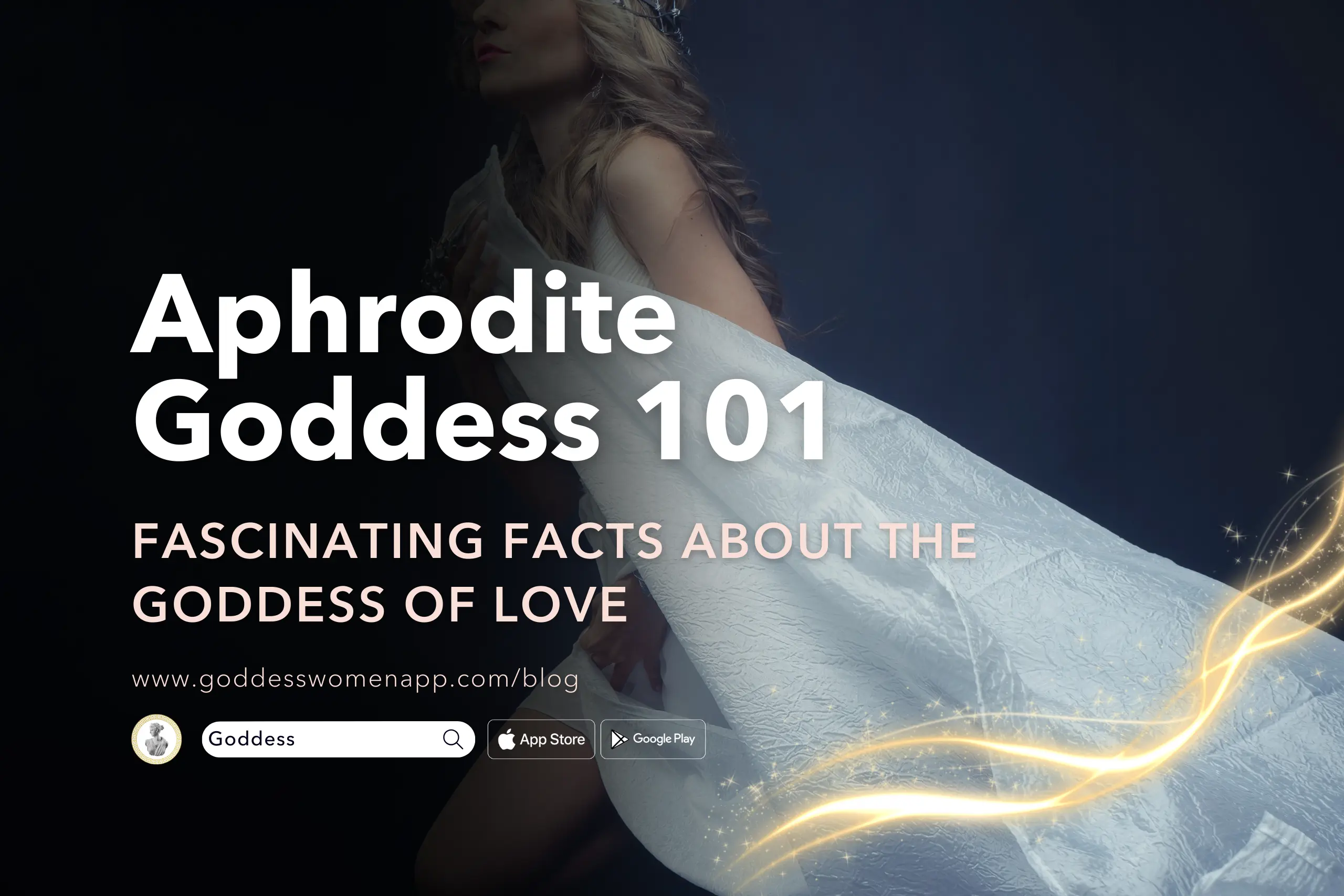Aphrodite Goddess 101: Fascinating Facts About the Goddess of Love
Introduction: The Ultimate Guide to Aphrodite, the Goddess of Love
Aphrodite goddess of love and beauty, is one of the most captivating figures in Greek mythology. Her origins, often depicted with her emerging from the sea foam near the island of Cyprus, link her to the sea’s mysterious beauty. Ancient Greek myths recount how Aphrodite’s birth came from the severed genitals of Uranus, the sky god, casting her origin in an ethereal light that aligns closely with her role as the goddess of love. In classical mythology, Aphrodite was among the many gods who lived delicately on Mount Olympus, surrounded by other gods and goddesses like Zeus and Hera.
Her story is interwoven with the tales of many gods and mortals. Aphrodite married Hephaestus but had many lovers, including Ares, the god of war, and Adonis, whose death at the hands of a wild boar is one of her most famous stories. The goddess is also associated with her son Eros, the god of desire, and the sun god Aeneas, whom she bore as one of her children. Her role in the Trojan War is legendary, where she offered Paris the golden apple inscribed with “For the most beautiful woman,” igniting the epic conflict that would involve many gods.
Aphrodite’s worship was widespread in ancient Greece and Rome, where she became known as Venus. The Romans revered her as Venus Genetrix, the divine mother and goddess of fertility, often depicted in Roman marble copies of early Greek art. Her sacred bird, the dove, and symbols like the scallop shell are frequently featured in Greek art, votive offerings, and Roman literature by poets such as Ovid.
Despite being closely linked to beauty and desire, Aphrodite also had a nurturing side, serving as a surrogate mother to Adonis, and representing fertility in the ancient world. Her legacy persists in the arts, where she continues to inspire awe with her timeless beauty.

1. Origins of Aphrodite, the Greek Goddess
Aphrodite, the Greek goddess of love and beauty, has origins that reflect her power and allure. According to myth, she was born from the severed genitals of her father Uranus after they were cast into the sea. The resulting white foam produced Aphrodite, who emerged fully formed, gliding on a scallop shell to the island of Cyprus. This famous story set her apart as a goddess of unparalleled beauty, capturing the imaginations of the ancient Greeks.
In Greek mythology, Aphrodite’s birth was unique among the gods. Her eastern origins closely linked her to the ancient goddess Astarte, blending Greek and Near Eastern influences in her persona. This gave her a mysterious and potent allure that inspired many gods, mortal lovers, and artists alike. The Greeks depicted her with unparalleled grace, showing her delicate yet captivating beauty in various forms of Greek art.
As the goddess of love and beauty, Aphrodite quickly became an object of worship, inspiring fervent devotion across ancient Greece. Her sacred bird, the dove, often appeared alongside her in depictions, symbolizing peace and desire. Roman poets admired Aphrodite, reimagining her as Venus, and her legacy extended well into Rome.
The myths surrounding Aphrodite emphasize her influence over desire, beauty, and fertility. From her connections with many gods to her role as the most beautiful woman in classical mythology, Aphrodite’s origins reflect her timeless appeal.
2. Aphrodite: Goddess of Love and Beauty
In Greek mythology, Aphrodite is renowned as the goddess of love and beauty. Born from the white foam of the sea, her birth off the island of Cyprus is deeply embedded in ancient Greek lore. One of her most famous stories involves her emergence from the sea in a scallop shell, emphasizing her connection to the sea’s ethereal beauty and the divine power of love.
Aphrodite, a goddess worshipped fervently in ancient Greece and later in Rome as Venus, played a significant role in both classical mythology and early Greek art. She was believed to have emerged from the severed genitals of her father Uranus, an event that added to her mystique and set her apart from other gods and goddesses. As the story goes, Aphrodite married Hephaestus but had many lovers, including the god Ares and the mortal Adonis, who was killed by a wild boar.
Her involvement in the Trojan War, one of the most famous stories in Greek mythology, began with the golden apple inscribed “For the most beautiful woman.” Paris awarded this apple to Aphrodite, and in return, she promised him the love of Helen of Troy, sparking the legendary conflict. Aphrodite was closely linked to beauty and desire, and her worship included votive offerings that often depicted her as Venus Genetrix in Roman marble copies of early Greek sculptures.
Aphrodite had numerous children, including the sun god Aeneas, who would later become a hero in Roman lore. Her son Eros, the god of desire, and her relationship with Adonis, for whom she acted as a surrogate mother, highlighted her nurturing side. Throughout the centuries, many gods have admired Aphrodite for her allure, and her influence on women, beauty, and love is still evident today.
Despite the many gods and goddesses in Greek mythology, Aphrodite’s legacy as the goddess of love endures. From ancient Greek art to Roman poets and modern interpretations, her legacy as the goddess of love and beauty continues to captivate and inspire.

3. The Dual Nature of Aphrodite: Urania and Pandemos
Aphrodite’s unique position in Greek mythology is further highlighted by her dual nature: Aphrodite Urania and Aphrodite Pandemos. Aphrodite Urania, the celestial goddess, represented spiritual love and beauty, embodying the elevated, divine aspect of love. She was associated with the sky and was believed to influence the purest forms of affection.
In contrast, Aphrodite Pandemos represented earthly love, desire, and physical attraction. She governed the more earthly aspects of love that linked closely to fertility and desire. This duality underscores the complex and multifaceted nature of love itself, a concept revered by the ancient Greeks and Romans alike.
These two aspects of Aphrodite reflect the diversity of her influence, from her ethereal origins and ties to Mount Olympus to her earthy connections with mortals. The Greeks and Romans both worshipped Aphrodite in these dual roles, showing the breadth of her appeal in ancient culture.
4. The Lovers of Aphrodite: A Godly Love Triangle
Aphrodite, the goddess of love, had many lovers, but her most notable relationships involved a fascinating love triangle with Hephaestus and Ares. Aphrodite married Hephaestus, the god of fire, who created exquisite works of craftsmanship but lacked the physical allure that Ares possessed. This disparity led Aphrodite into an affair with Ares, the god of war, whose passionate nature was a stark contrast to her husband’s.
The myth of Aphrodite’s infidelity unfolds dramatically in Greek mythology. Hephaestus, discovering the affair, trapped the couple in a golden net and exposed them to the other gods. This event not only highlighted the complexities of their relationships but also the tension between love and power among the gods.
Despite the scandal, Aphrodite’s influence over desire and beauty remained undiminished. Her love life was full of both mortal lovers and other gods who admired her divine charm, showcasing the powerful allure she held in the ancient world.
5. Worship of Aphrodite in Ancient Greek Culture
Aphrodite, the goddess of love and beauty, held a significant place in ancient Greek culture and was worshipped across the Mediterranean. Her temples and sanctuaries were centers of devotion, with one of the most prominent being the sanctuary at Paphos in Cyprus, believed to be the place of her birth from sea foam.
Worshippers sought Aphrodite’s blessings for matters related to love, beauty, fertility, and desire. Votive offerings were commonly placed at her temples, ranging from intricately carved statues to small tokens that reflected the personal prayers of her followers. Her sacred bird, the dove, often adorned her altars as a symbol of peace and love.
In addition to formal worship, festivals were held in her honor, such as the Aphrodisia, celebrated in several cities across Greece. The festival involved processions, sacrifices, and feasting to honor Aphrodite’s role in maintaining beauty, love, and fertility.
6. Aphrodite’s Lovers and Offspring
Aphrodite’s romantic relationships spanned the divine and mortal realms, reflecting her influence over love and desire. While Aphrodite married Hephaestus, her most famous affair was with Ares, the god of war. Their passionate love produced several offspring, including Eros, the god of desire.
Among her mortal lovers, the most notable was Adonis, a handsome youth whose tragic death by a wild boar devastated Aphrodite. This story symbolizes the ephemeral nature of beauty and love, two qualities that Aphrodite embodied. Another notable mortal lover was Anchises, with whom she bore Aeneas, the Trojan hero destined for greatness.
These lovers and offspring highlight Aphrodite’s reach across the mythological world, linking her to gods, mortals, and the stories that bridge their realms. Her offspring often played significant roles in mythology, further cementing her impact on ancient Greek and Roman lore.
7. Aphrodite’s Influence on Ancient Greek Art and Culture
Aphrodite, the goddess of love and beauty, left a significant mark on ancient Greek art and culture. She was a frequent subject in early Greek art, where her image captured both the divine and sensual aspects of her character. Artists sought to embody her beauty, often portraying her emerging from the sea foam on a scallop shell, a reference to her birth off the island of Cyprus.
Greek mythology and classical mythology often depicted Aphrodite in scenes with other gods and mortal lovers. One of the most famous stories involves the golden apple inscribed “For the most beautiful woman,” given to her by Paris, which triggered the Trojan War. This pivotal myth highlights her influence over desire and fate, themes that resonated deeply in Greek art.
Roman poets like Ovid later celebrated Aphrodite, known to them as Venus. Artists replicated her form in Roman marble copies, emphasizing her role as Venus Genetrix, the maternal aspect of the goddess. Statues and reliefs showed her alongside her son Eros, while votive offerings in her temples depicted her with sacred birds, reinforcing her divine influence over fertility, love, and beauty.
8. Aphrodite’s Transformation into Venus, the Roman Goddess
As Greek mythology spread across the Mediterranean, Aphrodite’s identity evolved in the Roman world. She was transformed into Venus, the Roman goddess of love, beauty, and fertility, with attributes that mirrored her Greek origins but also adapted to Roman ideals. Romans saw her as Venus Genetrix, the mother of the Roman people, closely linked to their origin myth through her son Aeneas.
Venus retained much of Aphrodite’s mythology, including her role in sparking the Trojan War and her relationships with gods like Mars, the Roman equivalent of Ares. Romans expanded her worship, building grand temples in her honor and depicting her in countless artworks.
Aphrodite’s transition to Venus cemented her as a powerful symbol of love and beauty across cultures. The Romans elevated her status, intertwining her story with their own mythology and history. Despite the shift in cultural context, her influence over desire, fertility, and the arts remained unchallenged, leaving a lasting legacy in both Greek and Roman mythology.
9. Aphrodite’s Enduring Legacy as an Ancient Goddess
Aphrodite’s legacy as an ancient goddess of love and beauty endures through the ages. Her influence stretches beyond the myths of Greek and Roman antiquity into the modern era. In art, she remains a muse, inspiring countless depictions in painting, sculpture, and literature. The imagery of Aphrodite emerging from the sea foam on a scallop shell is among the most iconic visual representations of divinity.
As the goddess who embodied love, beauty, and desire, her stories have fascinated audiences for centuries. Her dual nature as both Aphrodite Urania, representing spiritual love, and Aphrodite Pandemos, symbolizing earthly desire, reveals the complexity of her character and the enduring human fascination with love in all its forms. Aphrodite’s enduring appeal lies in her timeless relevance, as she continues to symbolize the pursuit of love, beauty, and personal fulfillment.
Her transformation into Venus in Roman mythology further extended her reach, making her a figure deeply embedded in Western cultural heritage. The Romans’ adaptation of her myths and worship practices allowed her to transcend her Greek origins and become a universal symbol of desire and fertility.
Frequently Asked Questions
Who was Aphrodite in love with?
Aphrodite, the Greek goddess of love and beauty, had many lovers, both divine and mortal. In Greek mythology, she was married to Hephaestus, the god of blacksmiths and fire. However, her marriage was not characterized by fidelity, as she had numerous affairs. Her most well-known lover was Ares, the god of war. Their passionate relationship symbolized the union of love and conflict, resulting in several children, including Eros, the god of desire.
Among her mortal lovers, the most significant was Adonis, a beautiful youth whose tragic death deeply affected Aphrodite. Their love story is one of the most poignant in Greek mythology, symbolizing the fleeting nature of beauty and love. Aphrodite also had a relationship with Anchises, a Trojan prince, and they had a son named Aeneas, who became a legendary hero and founder of Roman culture. These relationships highlight Aphrodite’s influence over love and beauty, demonstrating how her affections could sway both gods and mortals.
What are Aphrodite’s three important powers?
Aphrodite’s three most important powers reflect her role as the goddess of love and beauty:
1. Love and Desire: Aphrodite had the power to incite love and desire in gods and mortals alike. This influence was not just romantic but also encompassed the broader spectrum of attraction and affection. She could inspire the purest love between people and ignite passionate desires that could alter the course of history, as seen in her role in the Trojan War.
2. Beauty and Grace: As the goddess of beauty, Aphrodite could bestow physical allure and charm upon individuals, elevating their attractiveness. Her powers of beauty extended beyond the physical, affecting how individuals were perceived by others, making them more graceful and pleasing.
3. Fertility and Reproduction: Aphrodite was also linked to fertility, being able to bestow fruitfulness in nature and in human relationships. This power was integral to her role as a goddess, influencing the cycles of life, love, and reproduction. Through her influence, Aphrodite could ensure the continuation of life and the flourishing of families.
What was Aphrodite’s curse?
Aphrodite’s curse often relates to her involvement in myths where her influence on love brought about unfortunate consequences. One notable curse was on the women of Lemnos. After they neglected to honor Aphrodite properly, she cursed them with a foul odor that repelled their husbands, who then sought the company of other women.
Another famous curse was directed at Hippolytus, the son of Theseus. Aphrodite was angered by his devotion to the goddess Artemis and his rejection of love. She orchestrated a series of events that led to his tragic death, demonstrating the consequences of disregarding the goddess of love.
In the myth of Atalanta and Hippomenes, Aphrodite was angered that they did not honor her after she helped Hippomenes win the race and Atalanta’s hand in marriage. As punishment, she transformed the couple into lions after they desecrated one of her temples.
These stories highlight Aphrodite’s ability to use her powers of love and desire for both blessing and curse, depending on how she was honored.

Why is Aphrodite so special?
Aphrodite is special because she embodies the universal and timeless qualities of love, beauty, and desire. In a pantheon filled with diverse gods and goddesses, Aphrodite’s domain over the complexities of love makes her one of the most relatable deities in Greek mythology. She influenced human affairs through her ability to incite love and desire, a power that could lead to both joy and tragedy.
Her appeal lies in her duality: she is both a divine force and a deeply relatable figure. She is both the ethereal goddess of celestial love, Aphrodite Urania, and the goddess of earthly passion, Aphrodite Pandemos. This versatility allowed her to influence all aspects of love, from the purest affection to the most intense desires.
Her mythological narratives explore themes of passion, betrayal, and the transient nature of beauty, which continue to resonate across cultures and eras. Aphrodite’s stories offer insights into human nature and relationships, making her a timeless symbol of love and beauty that transcends mythology.
Conclusion
Aphrodite’s legacy as the goddess of love and beauty remains strong, captivating imaginations and hearts across centuries. Her timeless appeal is rooted in her mythology, which offers profound insights into human emotions and desires. Whether portrayed as a divine muse or an influential force of nature, Aphrodite stands out as one of mythology’s most compelling figures.
To explore more about the archetype of the goddess, download the Goddess app and take the archetype quiz to discover how Aphrodite’s timeless legacy can resonate with your own journey toward love and beauty.







